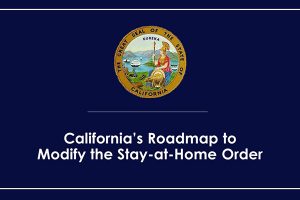 Governor Gavin Newsom yesterday outlined the six key indicators that will guide California’s decision on when to modify stay-at-home orders and slowly begin reopening the state’s economy.
Governor Gavin Newsom yesterday outlined the six key indicators that will guide California’s decision on when to modify stay-at-home orders and slowly begin reopening the state’s economy.
The Governor noted that the progress in flattening the curve, increased preparedness of the state’s health care delivery system and the effects of other COVID-19 interventions have yielded positive results. These actions, however, have also affected the economy and poverty in California, with 2.3 million unemployment claims filed in the last four weeks alone.
Any consideration of modifying the stay-at-home order must be done using a gradual, science-based and data-driven framework, Newsom said.
California Chamber of Commerce President and CEO Allan Zaremberg issued the following statement in response to the Governor’s announcement yesterday:
“The Governor clearly understands the importance of reopening California’s economy. His comments reflect the reality that workers, employers and customers must all feel safe in order to begin participating in the economy once again,” Zaremberg said. “As our employers look toward rebuilding their businesses and providing the services Californians need and want, it is critical that we focus on developing workable physical distancing protocols and other measures that both provide necessary levels of safety for all and maximize the number and kinds of operations that are allowed to rejoin the economy.”
Guidelines
Newsom said there is not a precise timeline for modifying the stay-at-home order, but that the following six indicators will serve as the framework for making that decision:
- The ability to monitor and protect communities through testing, contact tracing, isolating, and supporting those who are positive or exposed. One key question the state will consider, for example, is how prepared the state is to test everyone who is symptomatic.
- The ability to prevent infection in people who are at risk for more severe COVID-19. One key question the state will consider is if a plan has been developed to quickly identify and contain outbreaks in facilities housing older Californians, those living with disabilities, those currently incarcerated, and those with co-morbidities.
- The ability of the hospital and health systems to handle surges. For example, does the state have adequate bed capacity, staff and supplies, such as ventilators and masks?
- The ability to develop therapeutics to meet the demand. For example, have potential therapeutics been identified that have shown promise?
- The ability for businesses, schools, and child care facilities to support physical distancing. For example, has the state worked with businesses to support physical distancing practices and introduced guidelines to provide health checks when employees or the general public enter the premises?
- The ability to determine when to reinstitute certain measures, such as the stay-at-home orders, if necessary. One key question the state will consider is whether it is tracking the right data to provide an early warning system.
Newsom emphasized that even when stay-at-home orders are lifted, society will not instantly be back to normal.
“There’s no light switch here. It’s more like a dimmer,” he said. “Normal, it will not be until we have herd immunity and a vaccine.”
For example, he added, while restaurants may open, waiters may have to wear gloves and face masks, or customers entering the establishment will first have to have their temperatures checked. Face coverings will likely become common in public settings as well.
A PowerPoint presentation of the Governor’s guidance, California’s Roadmap to Modify the Stay-at-Home Order, can be found at https://www.gov.ca.gov/wp-content/uploads/2020/04/California-Roadmap-to-Modify-the-Stay-at-Home-Order.pdf.


